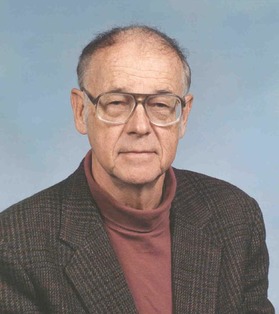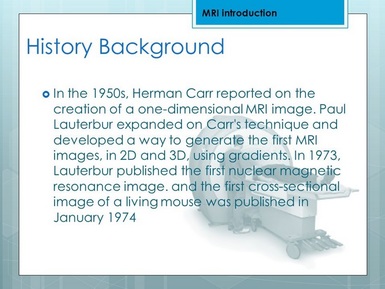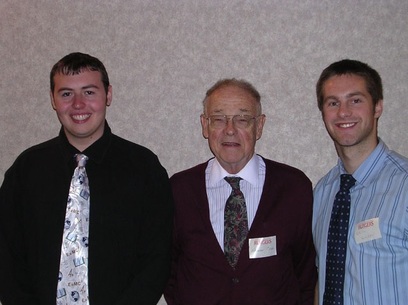 Dr. Herman Y. Carr (Source: physics.rutgers.edu)
Dr. Herman Y. Carr (Source: physics.rutgers.edu)
Dr. Herman Y. Carr – Graduated 1943; Inducted 1986
After graduating from Alliance High School, Dr. Carr served in World War II as a sergeant in the 12th Weather Squadron Army Air Corps in Italy. After the war, he attended Kenyon College and Harvard University graduating in 1948 from Harvard, Summa Cum Laude with a Bachelor’s degree in Physics. He received his Master’s degree from Harvard in 1949 and his Ph.D. in 1953, also from Harvard University. His doctoral thesis, published in 1952, described techniques for using gradients in magnetic fields and was the first example of magnetic resonance imaging or MRI.
Dr. Carr became an assistant professor of Physics at Rutgers University in 1952. In 1958 he was made associate professor of Physics and from 1964 to the present he has been a full professor of Physics at Rutgers. He also has been a Guggenheim Foundation Fellow and has conducted cooperative research at the University of Amsterdam, Van der Waals laboratory on Phase Transitions and Critical Phenomena.
After graduating from Alliance High School, Dr. Carr served in World War II as a sergeant in the 12th Weather Squadron Army Air Corps in Italy. After the war, he attended Kenyon College and Harvard University graduating in 1948 from Harvard, Summa Cum Laude with a Bachelor’s degree in Physics. He received his Master’s degree from Harvard in 1949 and his Ph.D. in 1953, also from Harvard University. His doctoral thesis, published in 1952, described techniques for using gradients in magnetic fields and was the first example of magnetic resonance imaging or MRI.
Dr. Carr became an assistant professor of Physics at Rutgers University in 1952. In 1958 he was made associate professor of Physics and from 1964 to the present he has been a full professor of Physics at Rutgers. He also has been a Guggenheim Foundation Fellow and has conducted cooperative research at the University of Amsterdam, Van der Waals laboratory on Phase Transitions and Critical Phenomena.
 Magnetic Resonance Imaging (Source: slideplayer.com)
Magnetic Resonance Imaging (Source: slideplayer.com)
Dr. Carr is co-author of a college physics textbook, Physics from the Ground Up published in 1971. He has written numerous articles for the American Journal of Physics and Bulletins of American Physical Society. An article entitled, Effect of Diffusion on Free Procession in Nuclear Magnetic Resonance Experiments was designated by the Institute for Scientific Information as one of the most cited articles ever published. Dr. Carr is listed in Who’s Who in America and American Men of Science.
As a dedicated educator, Doctor Carr worked on behalf of the civil rights movement and the United Farm Workers. He helped organize programs for black and Hispanic groups in New Brunswick, New Jersey and helped establish tutorial programs for underprivileged youth. During World War II, he was active with the Baptist Orphanage in Rome and still continues this relationship. He has always been a friend and help to foreign students studying in the United States.
As a dedicated educator, Doctor Carr worked on behalf of the civil rights movement and the United Farm Workers. He helped organize programs for black and Hispanic groups in New Brunswick, New Jersey and helped establish tutorial programs for underprivileged youth. During World War II, he was active with the Baptist Orphanage in Rome and still continues this relationship. He has always been a friend and help to foreign students studying in the United States.
 Dr. Herman Carr between Rutgers students Joseph Wolf (L) and Neil Wilson (r), recipients of the 2005-2006 Herman Y. Carr Scholarship in Physics and Astronomy for academic excellence. (Source: physics.rutgers.edu)
Dr. Herman Carr between Rutgers students Joseph Wolf (L) and Neil Wilson (r), recipients of the 2005-2006 Herman Y. Carr Scholarship in Physics and Astronomy for academic excellence. (Source: physics.rutgers.edu)
Biographical update: Dr. Carr became a Professor Emeritus in 1987. In 2001, an anonymous donation created two Herman Y. Carr Scholarships in Physics and Astronomy at Rutgers University to be awarded annually for outstanding academic excellence.
In 2003 the Nobel Prize in Medicine was awarded to Paul C. Lauterbur and Peter Mansfield for their work on MRI causing some controversy when Dr. Carr was not included as a joint recipient.
Dr. Carr passed away on April 9, 2008 at his home in Bridgewater, N.J. He was preceded in death by his former spouse Hilda Hagan Carr Kinney who passed away on August 29, 1986. He is survived by a daughter, Amanda Carr Sozer of Alexandria, VA, a son, Robert (Nancy) Carr of Amsterdam, NY, a step-son John Kinney of Wachung, NJ and three grandchildren. Dr. Carr, who remained scientifically active until his death, was scheduled to speak to the International Society for Magnetic Resonance in Medicine in Toronto the next month.
In 2003 the Nobel Prize in Medicine was awarded to Paul C. Lauterbur and Peter Mansfield for their work on MRI causing some controversy when Dr. Carr was not included as a joint recipient.
Dr. Carr passed away on April 9, 2008 at his home in Bridgewater, N.J. He was preceded in death by his former spouse Hilda Hagan Carr Kinney who passed away on August 29, 1986. He is survived by a daughter, Amanda Carr Sozer of Alexandria, VA, a son, Robert (Nancy) Carr of Amsterdam, NY, a step-son John Kinney of Wachung, NJ and three grandchildren. Dr. Carr, who remained scientifically active until his death, was scheduled to speak to the International Society for Magnetic Resonance in Medicine in Toronto the next month.